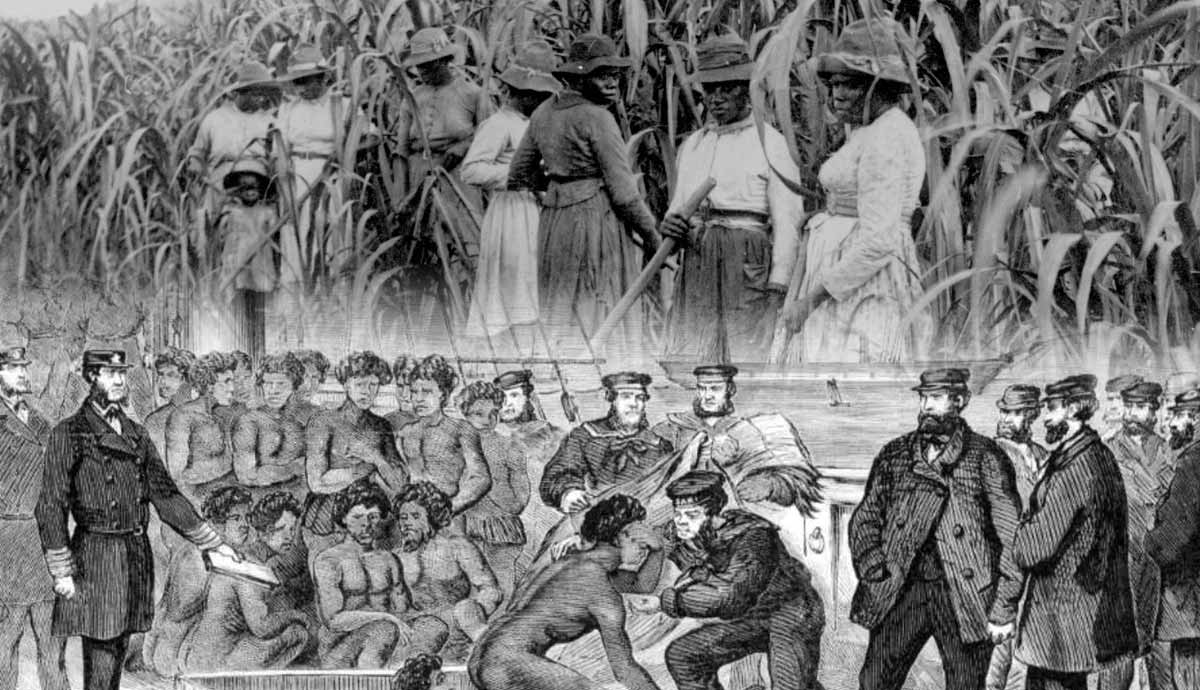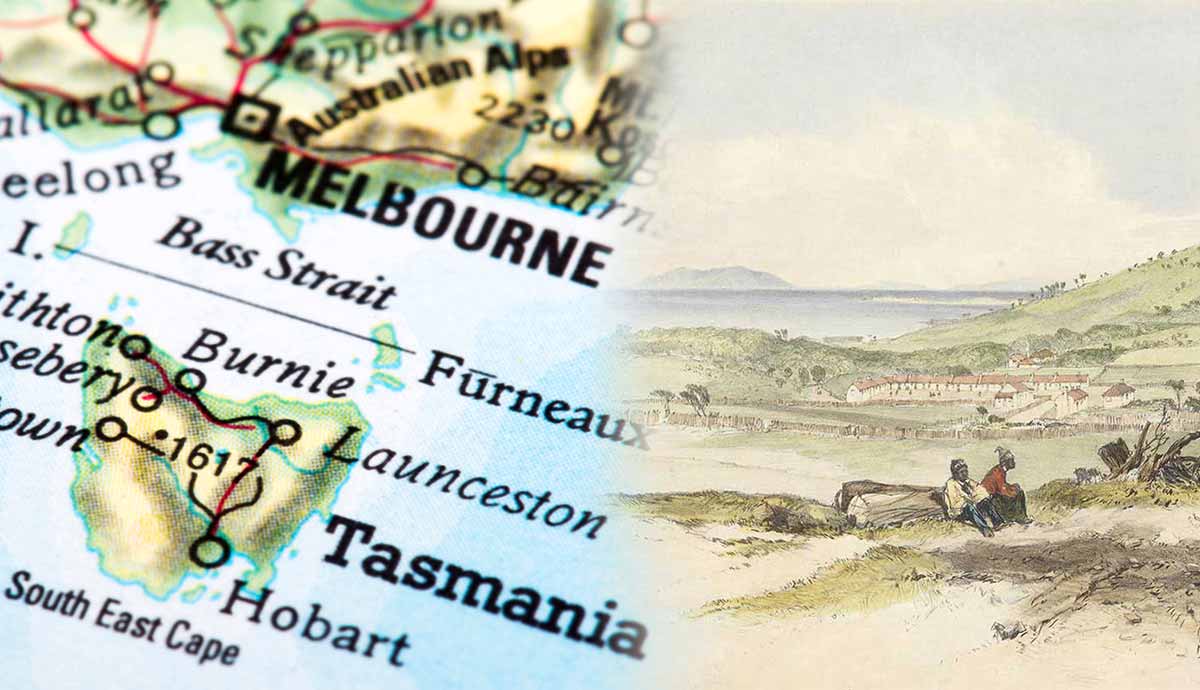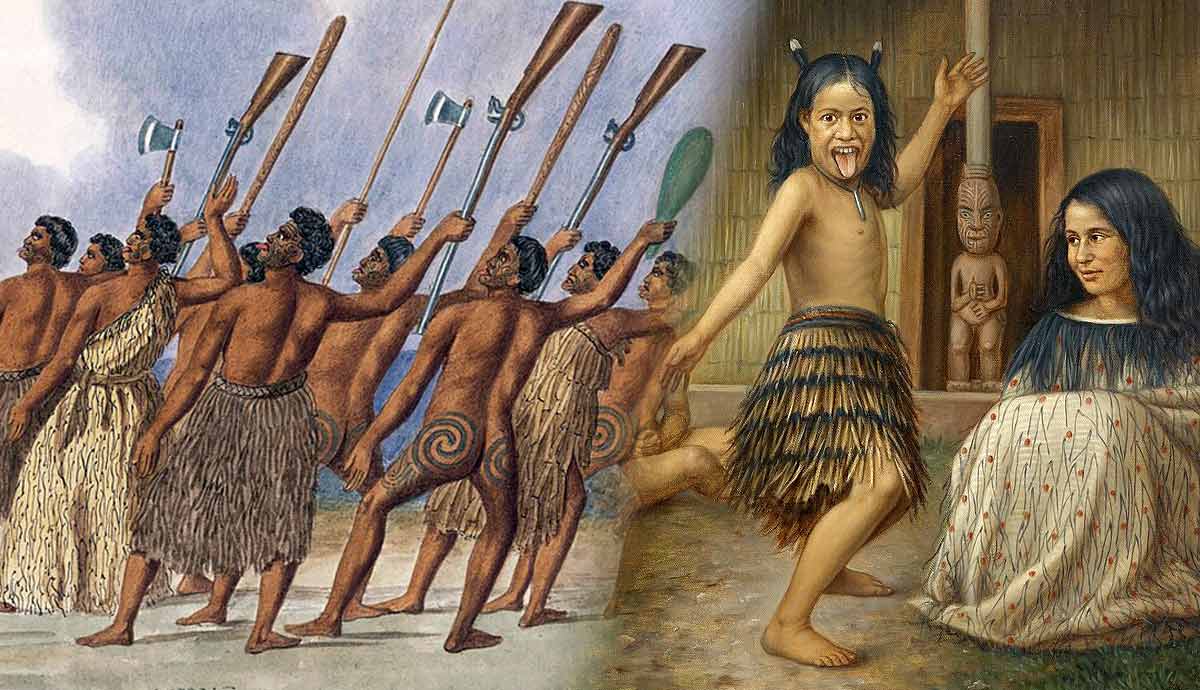
From 1863 to the early 20th century, over 62,000 Torres Strait Islander men, women, and children were uprooted from their ancestral lands and brought to Queensland, Australia, to work on sugar cane farms. Many were taken by force, while others were deceived with false promises of decent working conditions and fair pay.
This practice, now known as “blackbirding,” continued for four decades until 1901, when Queensland joined the Commonwealth of Australia. Historians are conflicted about the definition of blackbirding as a form of slavery. What is certain is that the economy of Queensland (and Australia as a whole) greatly benefited from the hard work of generations of South Sea Islanders, whose efforts, stories, and struggles are rarely remembered in history books.
When and Where?

In the early 19th century, Queensland was a part of New South Wales, a penal colony run by the British Crown. In 1859, Queen Victoria granted Queensland its independence and the “land of the Queen” became a separate self-governing colony. One year later, the first elections were held and in May the Queensland Parliament became fully operative.
The first cane plantation in Queensland was established near Brisbane in 1862 by John Buhot and Captain Louis Hope (1817-1894), grazier, miller, and later a Member of the Queensland Legislative Council. According to the data provided by the Australian Department of Agriculture, Fisheries, and Forestry, today “around 95 per cent of sugar produced in Australia is grown in Queensland and about five per cent in northern New South Wales, along 2,100 km of coastline between Mossman in far north Queensland and Grafton in northern New South Wales.”

From the early 19th century until 1840, convicts had been the backbone of the Australian economy. They represented a huge pool of cheap labor that colonies knew they could rely on without worrying too much about their rights and working conditions. In 1840, however, convict transportation from Europe ceased. This led to a shortage of workers, a vacuum soon filled by South Sea Islanders.
Estimated to be between 62,000 and 62,500 in number, they were brought to Queensland between 1863 and 1904 (the exact number is impossible to know for obvious reasons). The first group of 67 men and women were employed on a cotton plantation in Brisbane but were later sent to work in the cane fields. They were commonly known as “Kanakas.”

These people came from at least 80 Pacific islands. Some of them were blackbirded from the Melanesia subregion, namely, the Solomon Islands (colloquially known as the Solomons), Fiji, Vanuatu (also known as New Hebrides), and Papua New Guinea, the latter being one of the largest islands in the area and the world’s third largest island country. Others came from the Gilbert Islands, a chain of coral islands and atolls in Micronesia, and still, others hailed from the region of Polynesia, Tuvalu, and Samoa.
It is worth remembering that all these islands and archipelagos had been inhabited for centuries before the coming of Europeans and that the cultures, languages, and beliefs of their traditional owners were and are as elaborate as those of the people who colonized them.
Was “Blackbirding” Slavery?

The United Nations defines the slave trade as including “all acts involved in the capture, acquisition or disposal of a person with the intent to reduce him to slavery; all acts involved in the acquisition of a slave with a view to selling or exchanging him; all acts of disposal by sale or exchange of a slave acquired with a view to being sold or exchanged, and, in general, every act of trade or transport in slaves.” There is an ongoing debate among historians about whether the colonial practice of blackbirding can be considered a form of slavery. It is beyond doubt, however, that South Sea Islanders endured awful working conditions; despite what they were initially promised, most workers never received any remuneration and in the rare instances when they did get paid, their salaries were embarrassingly low.
Although not all South Sea Islanders who relocated to Queensland during the blackbirding era were kidnapped, many of those who did so willingly were deceived by false promises. The traditions and cultural practices of these workers were also indirectly attacked.
Can this attack and the working conditions many endured be equated to slavery? Was Queensland a “slave state”? Can we dub Townsville in Queensland the capital of a “slave state”? The debates continue. It’s worth remembering that blackbirding was never legal, and the Queensland government introduced several legislations to try to regulate and halt the practice. For example, in 1868, the Polynesian Labourers Act 1868 was passed in an attempt to prevent the exploitation and kidnapping of South Sea Islanders although many plantation owners and labor agents found ways to get around the law.
How Did Australia Benefit From “Blackbirding”?

For a long time, the use of South Sea Islanders in tropical Queensland was justified by the self-serving colonial narrative which claimed that white European men, who mostly hailed from colder regions such as the British Isles and northern Europe, did not possess the physical strength to work long hours in the tropical climate of Queensland. South Sea Islanders did and were therefore deemed fit for the job.
The reality was that most white Australians or white immigrants felt that working in the fields was degrading and socially beneath them. Only “Black men” (which was essentially used as an all-encompassing label) could and would accept the hard-working conditions required to make a sugar cane plantation flourish.

Ironically, a few decades later the so-called white Australia movement began to actively oppose blackbirding and the presence of South Sea Islanders on Australian soil, although not for humanitarian reasons. By today’s standards, their concern was purely and openly racist. They believed that Islanders, just like workers from Japan or China, were diluting the country’s whiteness, in addition to taking jobs away from white Australians of European descent.
In 1901, the federal government led by Edmund Barton passed the Immigration Restriction Act, which came into law on December 23, 1901, and effectively favored immigration from the British Isles over that from other non-white, non-Anglophone nations. The white Australia policy was now safeguarded and legitimized by law.
For the next few decades and until the late 1960s, Australia was to become a white nation built on the exploitation of non-white men and women. Indeed, as we can read on the poster designed by Aboriginal artist Laurie Nilsen (1953-2020) for the National Aboriginal and Islander Day Observance Committee (NAIDOC) of 1987: “White Australia has a Black History.”
First Kidnapped, Then Deported

In Australia, the 20th century began under the banner of the “white Australia” policy. In addition to the Immigration Restriction Act, Australia’s new federal government passed the Pacific Island Labourers Act, which essentially made it illegal for any Pacific Islanders to enter the country after March 31, 1904. The Act was officially headed as “an Act to provide for the Regulation, Restriction, and Prohibition of the Introduction of Labourers from the Pacific Islands and other purposes.”
Starting in December 1906, any Pacific Islander found on Australian soil could be deported immediately. Employing a Pacific Islander was punishable by law. Over two years, from 1906 to 1908, more than 7,500 South Sea Islanders, most of whom were actually born in Australia, were forcibly deported to their “home country.”

Many South Sea Islanders possessed very little knowledge of the “home country” Australia was sending them back to. It was the country of their parents and grandparents, not theirs. Just 1654 South Sea Islanders were officially allowed to remain in Australia (although there is evidence that the actual number was closer to 2500). Some of them had been brought to Queensland before September 1, 1879. This was the first of the exemptions under the Act. South Sea Islanders employed in ships’ crews were also allowed to stay, as were those in possession of a license allowing them to work under forced labor contracts and those who had been granted an exemption under the Immigration Restriction Act 1901. It took Australia almost a century to come to terms with this dark part of its history. For decades, many knew nothing about blackbirding.
Finally, in 1994 the Commonwealth government publicly acknowledged the distinctiveness of Australian South Sea Islander culture, and six years later, in 2000, the Queensland Government followed suit. Today, on August 25, Australians celebrate South Sea Islander Recognition Day.
In August 2021, Jack Dempsey, the Mayor of Bundaberg, the tenth-largest city in Queensland, issued an official apology to the region’s South Sea Islanders for the “abuse which occurred in ‘blackbirding’ people from Vanuatu and other Pacific Islands to work in the Queensland sugarcane industry,” which was built, he said, “on the backs of Pacific Island labor, along with much of our infrastructure.”
The apology was long overdue, he added, and “saying sorry is necessary for healing and to move forward in friendship.” Bundaberg is now in a “Sister City” agreement with Luganville in Vanuatu.
But Why “Blackbirding”?

The origins of the term “blackbirding” are controversial; 19th-century sailors, merchants, and dock workers referred to the slave trade as “blackbird-catching.” The term blackbirds was used to identify people from the African continent, especially those living along the African coast, due to the color of their skin. Blackbird was also the slang term for the slaving ship that transported slaves from Africa to the North American continent. From identifying people with a dark skin color in general, the term came to identify South Sea Islanders or any native of the South Pacific Islands. In Australia “blackbird shooting” was commonly used to describe the killing of Aboriginal people at the hands of white settlers and explorers.
In North America as well as in the Pacific, the term blackbirding was first and foremost dehumanizing. It equated human beings with animals and established a color-based hierarchy: the whiter you were, the more powerful. The darker your skin was, the more easily you could (and would) be exploited and mistreated, both physically and mentally.
For far too long, the history of South Sea Pacific Islanders and the slave-like conditions they endured while working on sugarcane plantations in Queensland and New South Wales has been overlooked, if not entirely forgotten. Today, Australia is finally beginning to confront this dark chapter in its colonial history.







